Finance for Managers: Capital Budgeting and Working Capital Analysis
VerifiedAdded on 2020/03/13
|9
|1238
|71
Homework Assignment
AI Summary
This finance assignment delves into several key areas of financial management. It begins by calculating the cost of capital, including the cost of debt, preferred stock, and common stock, providing a detailed breakdown of the formulas and figures. The assignment then explores capital budgeting techniques, specifically comparing electric-powered and gas-powered trucks using Net Present Value (NPV) and Internal Rate of Return (IRR) methods to determine the most financially viable option. It also considers qualitative factors influencing capital investment decisions, such as organizational culture, product quality, and ethical considerations. Furthermore, the assignment analyzes the importance of working capital, discussing its role in maintaining business solvency, promoting goodwill, securing loans, and facilitating efficient operations. It highlights how adequate working capital enables companies to exploit market opportunities and ensure timely returns on investment. The assignment provides calculations and explanations to support its conclusions, offering a comprehensive overview of financial management principles.

Running head: FINANCE FOR MANAGERS
Finance for Managers
Name of the Student:
Name of the University:
Author’s Note:
Course ID:
Finance for Managers
Name of the Student:
Name of the University:
Author’s Note:
Course ID:
Paraphrase This Document
Need a fresh take? Get an instant paraphrase of this document with our AI Paraphraser
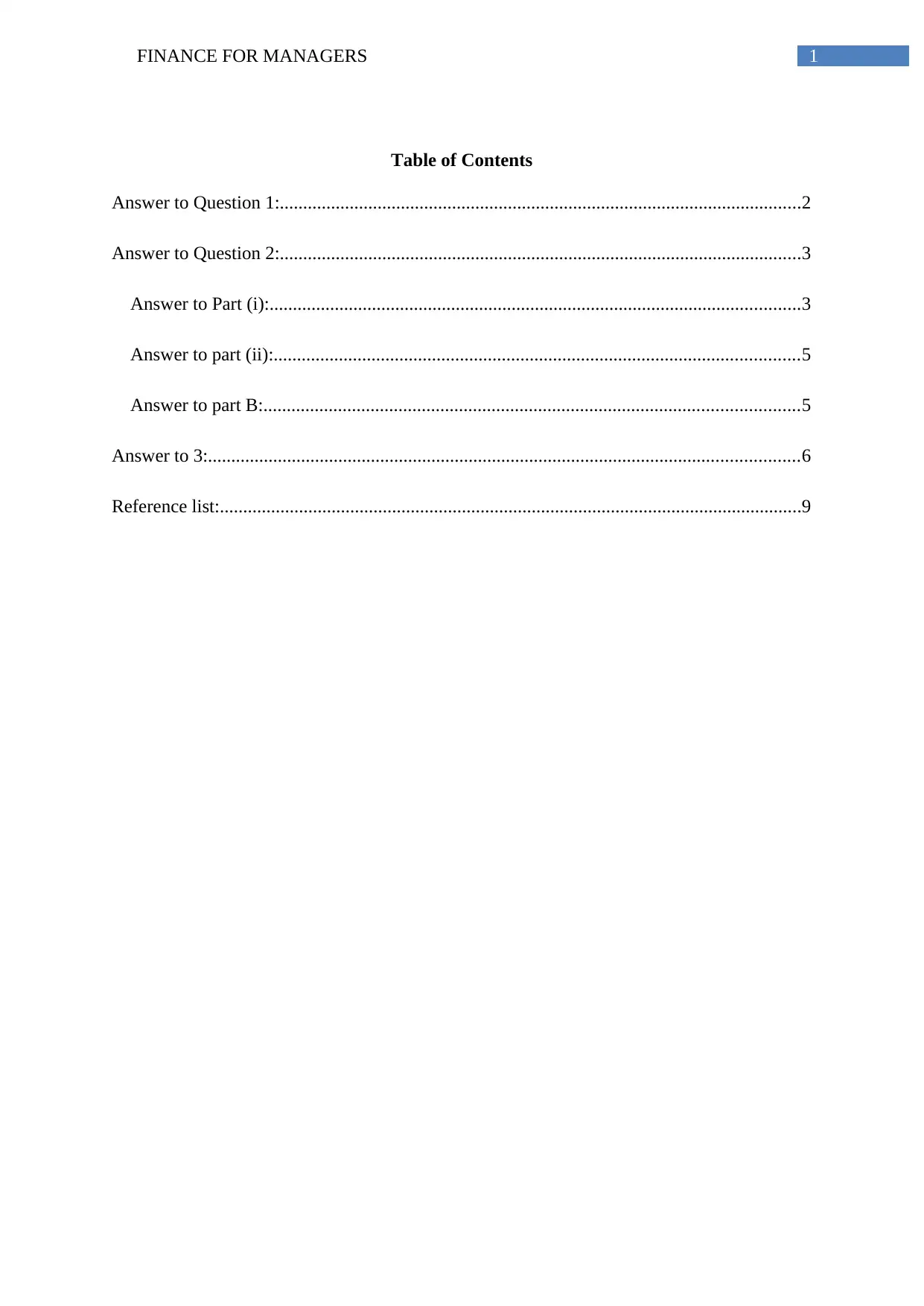
1FINANCE FOR MANAGERS
Table of Contents
Answer to Question 1:................................................................................................................2
Answer to Question 2:................................................................................................................3
Answer to Part (i):..................................................................................................................3
Answer to part (ii):.................................................................................................................5
Answer to part B:...................................................................................................................5
Answer to 3:...............................................................................................................................6
Reference list:.............................................................................................................................9
Table of Contents
Answer to Question 1:................................................................................................................2
Answer to Question 2:................................................................................................................3
Answer to Part (i):..................................................................................................................3
Answer to part (ii):.................................................................................................................5
Answer to part B:...................................................................................................................5
Answer to 3:...............................................................................................................................6
Reference list:.............................................................................................................................9
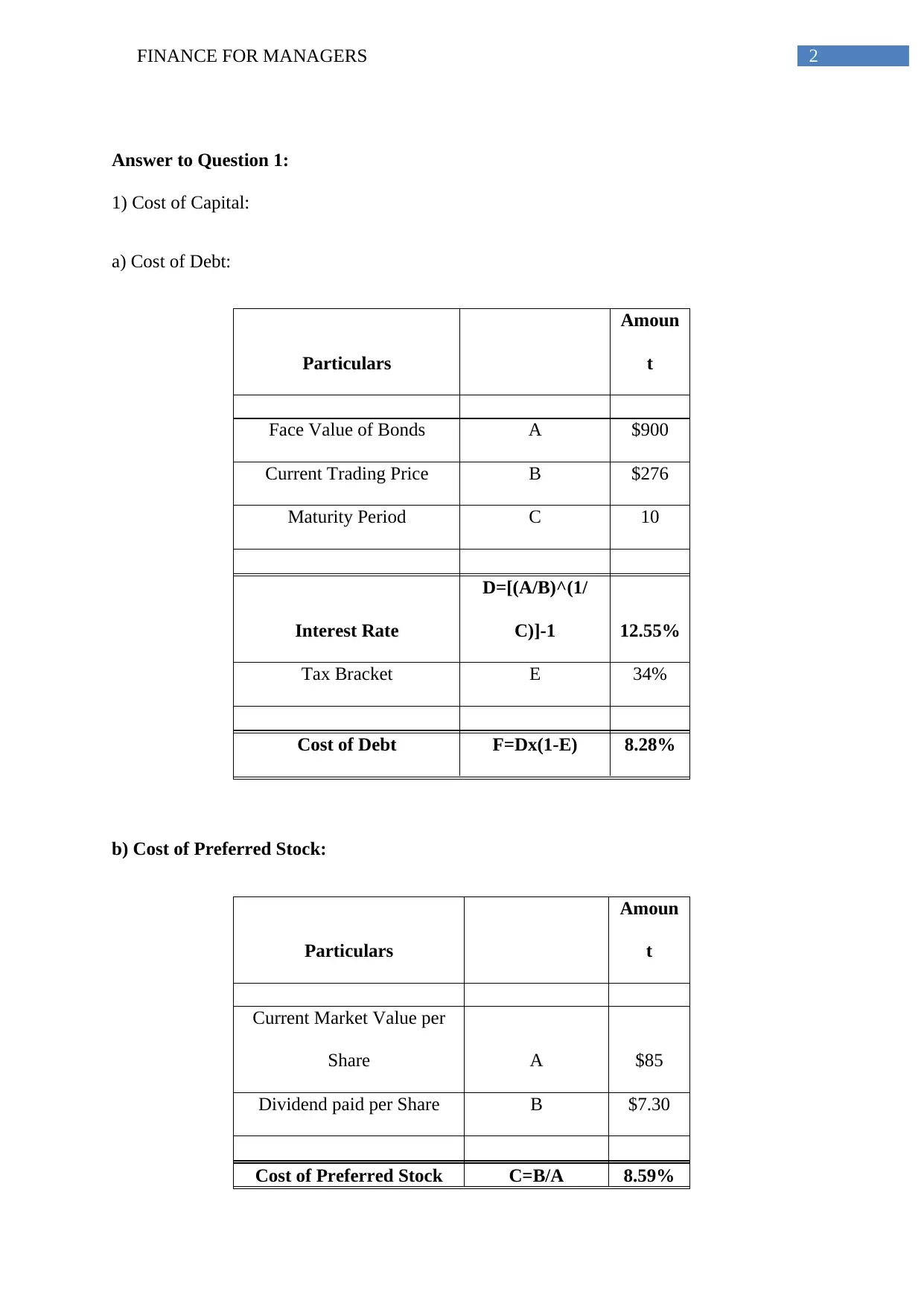
2FINANCE FOR MANAGERS
Answer to Question 1:
1) Cost of Capital:
a) Cost of Debt:
Particulars
Amoun
t
Face Value of Bonds A $900
Current Trading Price B $276
Maturity Period C 10
Interest Rate
D=[(A/B)^(1/
C)]-1 12.55%
Tax Bracket E 34%
Cost of Debt F=Dx(1-E) 8.28%
b) Cost of Preferred Stock:
Particulars
Amoun
t
Current Market Value per
Share A $85
Dividend paid per Share B $7.30
Cost of Preferred Stock C=B/A 8.59%
Answer to Question 1:
1) Cost of Capital:
a) Cost of Debt:
Particulars
Amoun
t
Face Value of Bonds A $900
Current Trading Price B $276
Maturity Period C 10
Interest Rate
D=[(A/B)^(1/
C)]-1 12.55%
Tax Bracket E 34%
Cost of Debt F=Dx(1-E) 8.28%
b) Cost of Preferred Stock:
Particulars
Amoun
t
Current Market Value per
Share A $85
Dividend paid per Share B $7.30
Cost of Preferred Stock C=B/A 8.59%
⊘ This is a preview!⊘
Do you want full access?
Subscribe today to unlock all pages.

Trusted by 1+ million students worldwide
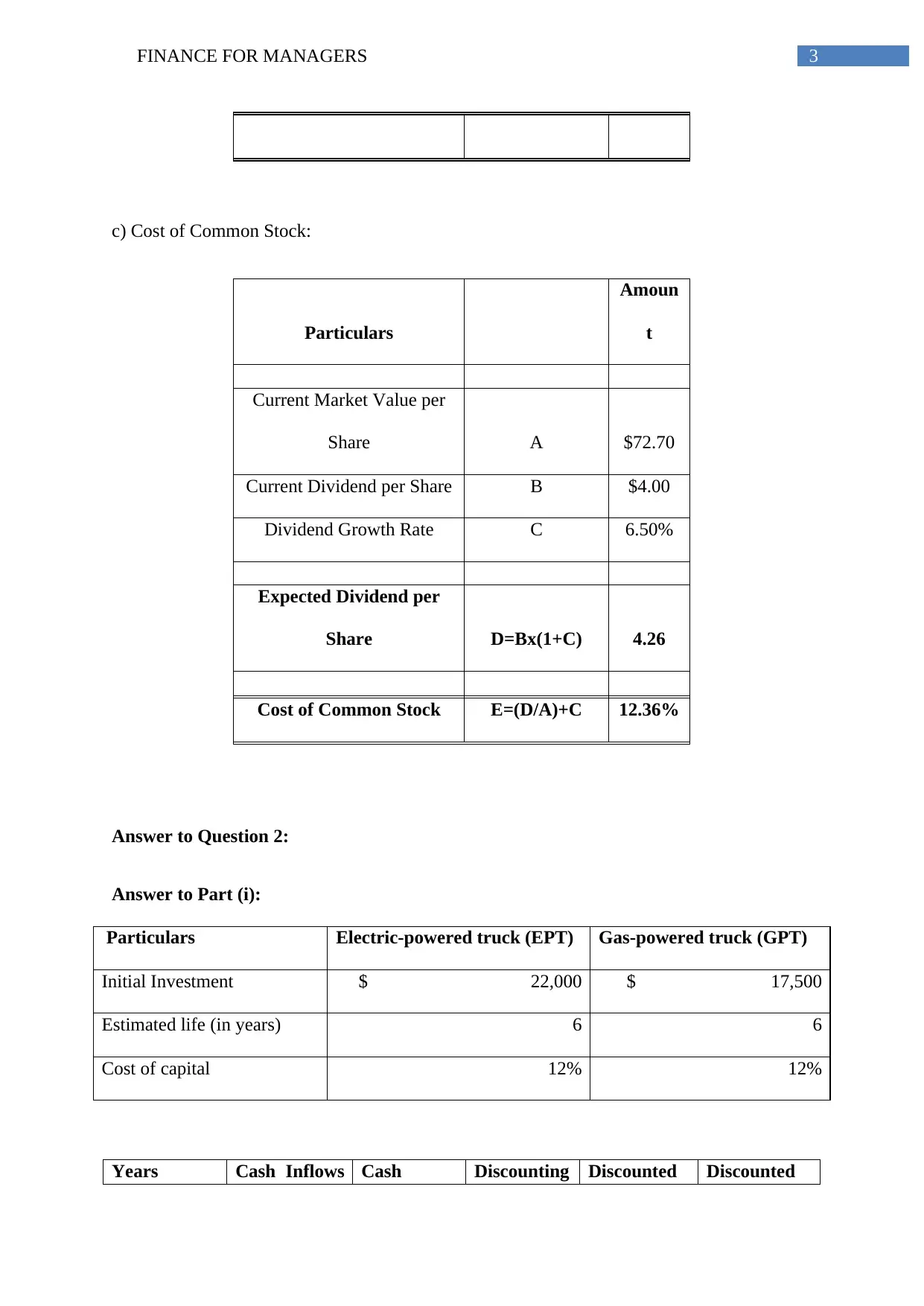
3FINANCE FOR MANAGERS
c) Cost of Common Stock:
Particulars
Amoun
t
Current Market Value per
Share A $72.70
Current Dividend per Share B $4.00
Dividend Growth Rate C 6.50%
Expected Dividend per
Share D=Bx(1+C) 4.26
Cost of Common Stock E=(D/A)+C 12.36%
Answer to Question 2:
Answer to Part (i):
Particulars Electric-powered truck (EPT) Gas-powered truck (GPT)
Initial Investment $ 22,000 $ 17,500
Estimated life (in years) 6 6
Cost of capital 12% 12%
Years Cash Inflows Cash Discounting Discounted Discounted
c) Cost of Common Stock:
Particulars
Amoun
t
Current Market Value per
Share A $72.70
Current Dividend per Share B $4.00
Dividend Growth Rate C 6.50%
Expected Dividend per
Share D=Bx(1+C) 4.26
Cost of Common Stock E=(D/A)+C 12.36%
Answer to Question 2:
Answer to Part (i):
Particulars Electric-powered truck (EPT) Gas-powered truck (GPT)
Initial Investment $ 22,000 $ 17,500
Estimated life (in years) 6 6
Cost of capital 12% 12%
Years Cash Inflows Cash Discounting Discounted Discounted
Paraphrase This Document
Need a fresh take? Get an instant paraphrase of this document with our AI Paraphraser
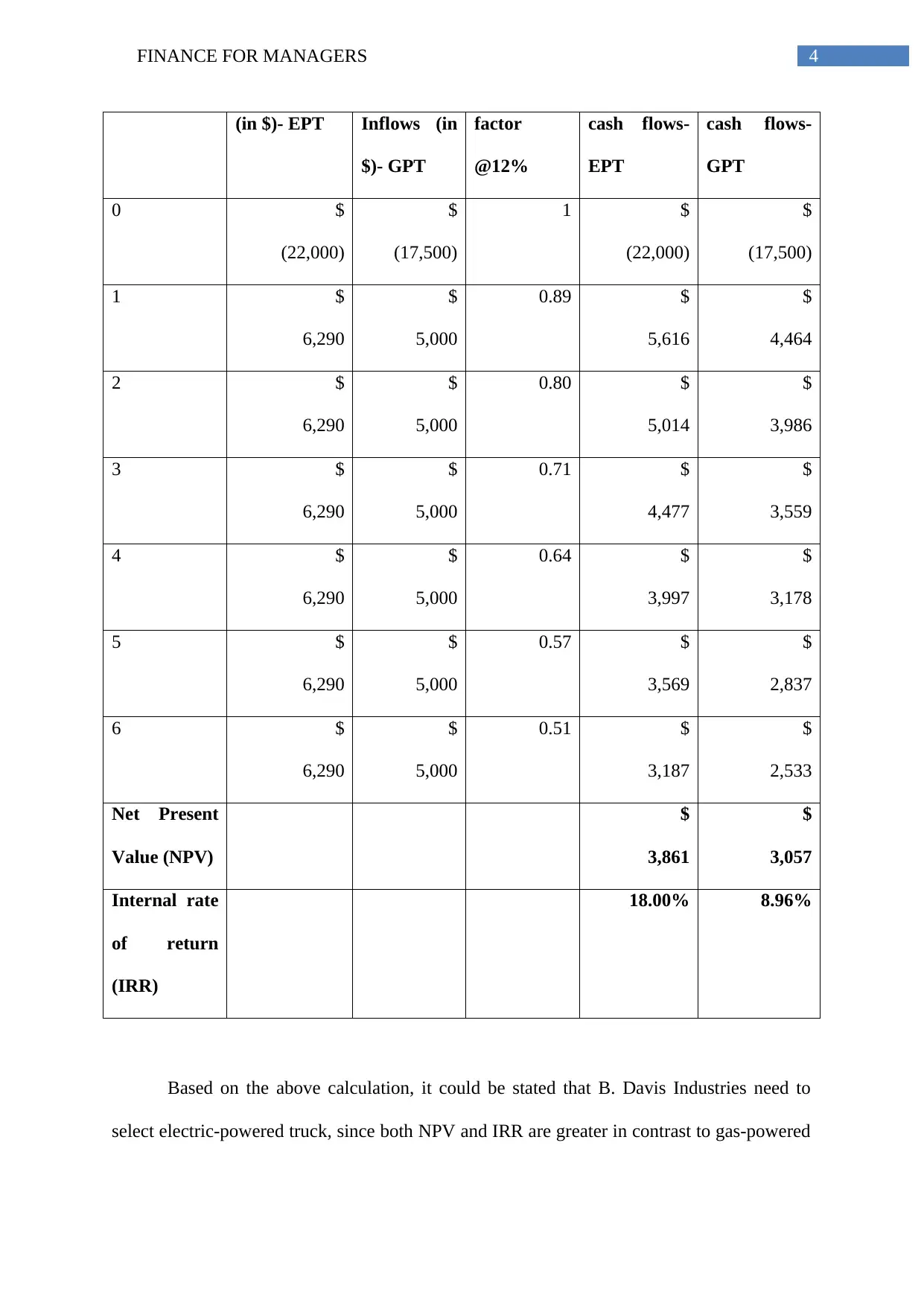
4FINANCE FOR MANAGERS
(in $)- EPT Inflows (in
$)- GPT
factor
@12%
cash flows-
EPT
cash flows-
GPT
0 $
(22,000)
$
(17,500)
1 $
(22,000)
$
(17,500)
1 $
6,290
$
5,000
0.89 $
5,616
$
4,464
2 $
6,290
$
5,000
0.80 $
5,014
$
3,986
3 $
6,290
$
5,000
0.71 $
4,477
$
3,559
4 $
6,290
$
5,000
0.64 $
3,997
$
3,178
5 $
6,290
$
5,000
0.57 $
3,569
$
2,837
6 $
6,290
$
5,000
0.51 $
3,187
$
2,533
Net Present
Value (NPV)
$
3,861
$
3,057
Internal rate
of return
(IRR)
18.00% 8.96%
Based on the above calculation, it could be stated that B. Davis Industries need to
select electric-powered truck, since both NPV and IRR are greater in contrast to gas-powered
(in $)- EPT Inflows (in
$)- GPT
factor
@12%
cash flows-
EPT
cash flows-
GPT
0 $
(22,000)
$
(17,500)
1 $
(22,000)
$
(17,500)
1 $
6,290
$
5,000
0.89 $
5,616
$
4,464
2 $
6,290
$
5,000
0.80 $
5,014
$
3,986
3 $
6,290
$
5,000
0.71 $
4,477
$
3,559
4 $
6,290
$
5,000
0.64 $
3,997
$
3,178
5 $
6,290
$
5,000
0.57 $
3,569
$
2,837
6 $
6,290
$
5,000
0.51 $
3,187
$
2,533
Net Present
Value (NPV)
$
3,861
$
3,057
Internal rate
of return
(IRR)
18.00% 8.96%
Based on the above calculation, it could be stated that B. Davis Industries need to
select electric-powered truck, since both NPV and IRR are greater in contrast to gas-powered
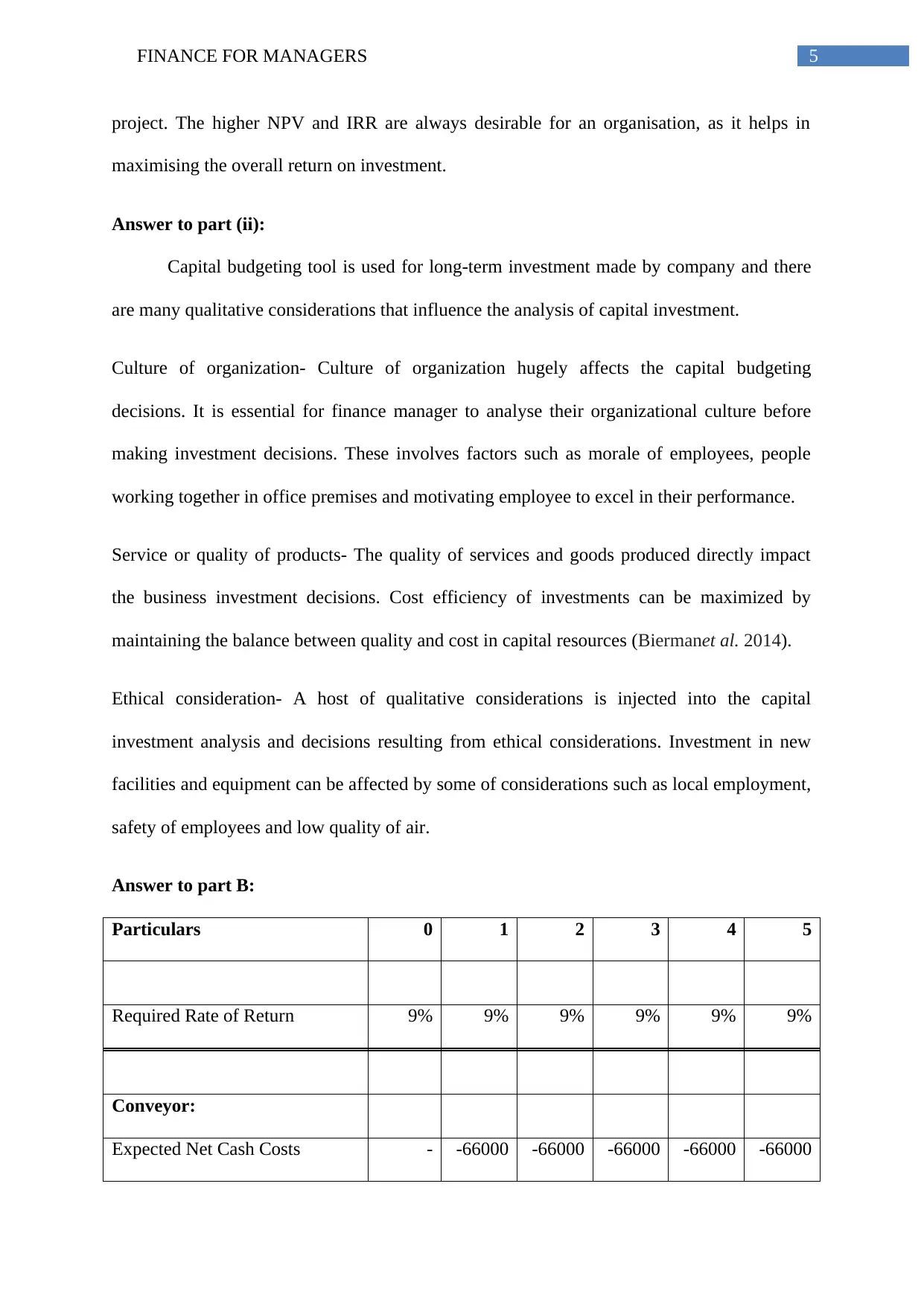
5FINANCE FOR MANAGERS
project. The higher NPV and IRR are always desirable for an organisation, as it helps in
maximising the overall return on investment.
Answer to part (ii):
Capital budgeting tool is used for long-term investment made by company and there
are many qualitative considerations that influence the analysis of capital investment.
Culture of organization- Culture of organization hugely affects the capital budgeting
decisions. It is essential for finance manager to analyse their organizational culture before
making investment decisions. These involves factors such as morale of employees, people
working together in office premises and motivating employee to excel in their performance.
Service or quality of products- The quality of services and goods produced directly impact
the business investment decisions. Cost efficiency of investments can be maximized by
maintaining the balance between quality and cost in capital resources (Biermanet al. 2014).
Ethical consideration- A host of qualitative considerations is injected into the capital
investment analysis and decisions resulting from ethical considerations. Investment in new
facilities and equipment can be affected by some of considerations such as local employment,
safety of employees and low quality of air.
Answer to part B:
Particulars 0 1 2 3 4 5
Required Rate of Return 9% 9% 9% 9% 9% 9%
Conveyor:
Expected Net Cash Costs - -66000 -66000 -66000 -66000 -66000
project. The higher NPV and IRR are always desirable for an organisation, as it helps in
maximising the overall return on investment.
Answer to part (ii):
Capital budgeting tool is used for long-term investment made by company and there
are many qualitative considerations that influence the analysis of capital investment.
Culture of organization- Culture of organization hugely affects the capital budgeting
decisions. It is essential for finance manager to analyse their organizational culture before
making investment decisions. These involves factors such as morale of employees, people
working together in office premises and motivating employee to excel in their performance.
Service or quality of products- The quality of services and goods produced directly impact
the business investment decisions. Cost efficiency of investments can be maximized by
maintaining the balance between quality and cost in capital resources (Biermanet al. 2014).
Ethical consideration- A host of qualitative considerations is injected into the capital
investment analysis and decisions resulting from ethical considerations. Investment in new
facilities and equipment can be affected by some of considerations such as local employment,
safety of employees and low quality of air.
Answer to part B:
Particulars 0 1 2 3 4 5
Required Rate of Return 9% 9% 9% 9% 9% 9%
Conveyor:
Expected Net Cash Costs - -66000 -66000 -66000 -66000 -66000
⊘ This is a preview!⊘
Do you want full access?
Subscribe today to unlock all pages.

Trusted by 1+ million students worldwide
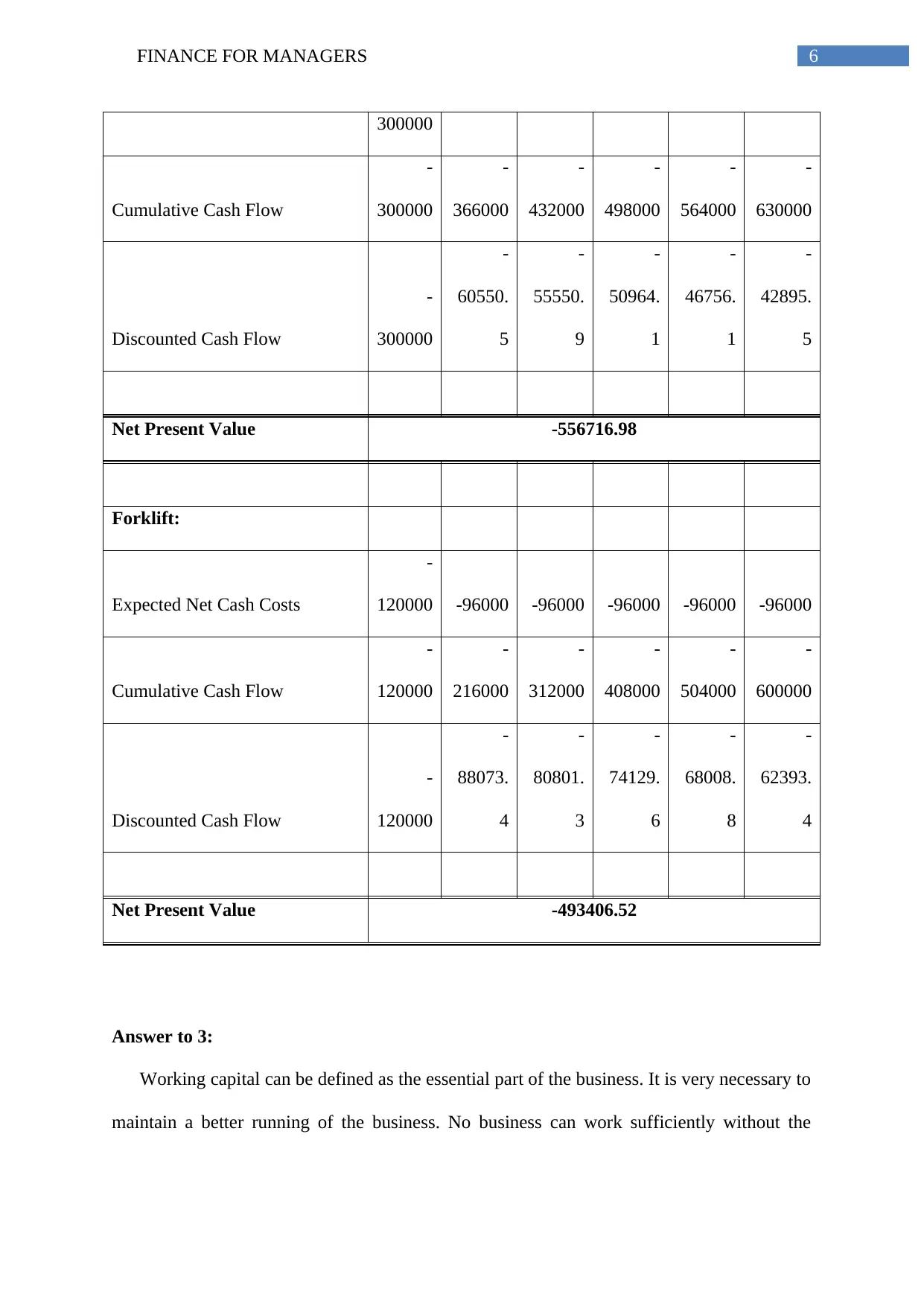
6FINANCE FOR MANAGERS
300000
Cumulative Cash Flow
-
300000
-
366000
-
432000
-
498000
-
564000
-
630000
Discounted Cash Flow
-
300000
-
60550.
5
-
55550.
9
-
50964.
1
-
46756.
1
-
42895.
5
Net Present Value -556716.98
Forklift:
Expected Net Cash Costs
-
120000 -96000 -96000 -96000 -96000 -96000
Cumulative Cash Flow
-
120000
-
216000
-
312000
-
408000
-
504000
-
600000
Discounted Cash Flow
-
120000
-
88073.
4
-
80801.
3
-
74129.
6
-
68008.
8
-
62393.
4
Net Present Value -493406.52
Answer to 3:
Working capital can be defined as the essential part of the business. It is very necessary to
maintain a better running of the business. No business can work sufficiently without the
300000
Cumulative Cash Flow
-
300000
-
366000
-
432000
-
498000
-
564000
-
630000
Discounted Cash Flow
-
300000
-
60550.
5
-
55550.
9
-
50964.
1
-
46756.
1
-
42895.
5
Net Present Value -556716.98
Forklift:
Expected Net Cash Costs
-
120000 -96000 -96000 -96000 -96000 -96000
Cumulative Cash Flow
-
120000
-
216000
-
312000
-
408000
-
504000
-
600000
Discounted Cash Flow
-
120000
-
88073.
4
-
80801.
3
-
74129.
6
-
68008.
8
-
62393.
4
Net Present Value -493406.52
Answer to 3:
Working capital can be defined as the essential part of the business. It is very necessary to
maintain a better running of the business. No business can work sufficiently without the
Paraphrase This Document
Need a fresh take? Get an instant paraphrase of this document with our AI Paraphraser

7FINANCE FOR MANAGERS
adequate amount of working capital. Working is necessary for meeting the challenges and
trade offs in the below listed process
a. Solvency of the business: Working capital is necessary in making the business in
maintaining the solvency of the business by rendering continuous flow of production.
b. Goodwill: Working capital helps in promoting goodwill which enables the business
to make quick payments and therefore assist in the creation and maintain creation of
goodwill.
c. Easy Loans: Working capital is necessary in having the instances of solvency with
better credit standing as this can arrange the loans from banks and favourable terms
(Drury 2013).
d. Cash discount: Adequate working capital also provides business to avail cash
discounts on purchase and therefore helps in meeting the challenges of higher cost by
reducing the cost.
e. Constant flow of supply and materials: Working capital ensures that there is a
constant supply of materials to make sure that there is regular supply of materials for
continuous production process.
f. Constant payment of salaries, wages and other business commitment: A company
that have sufficient amount of working capital can make the use of the sum in making
payments of salaries, wages to its staff with other daily business commitments. This
helps in meeting the challenges of low morale as the motivations of employees is
improved with increasing efficiency, low costs and wastage.
g. Capability of facing business crisis: Working capital is necessary in meeting the
requirement of adequate working capital as this enables the firms to meet the business
challenges during the phase of crisis such as depreciation.
adequate amount of working capital. Working is necessary for meeting the challenges and
trade offs in the below listed process
a. Solvency of the business: Working capital is necessary in making the business in
maintaining the solvency of the business by rendering continuous flow of production.
b. Goodwill: Working capital helps in promoting goodwill which enables the business
to make quick payments and therefore assist in the creation and maintain creation of
goodwill.
c. Easy Loans: Working capital is necessary in having the instances of solvency with
better credit standing as this can arrange the loans from banks and favourable terms
(Drury 2013).
d. Cash discount: Adequate working capital also provides business to avail cash
discounts on purchase and therefore helps in meeting the challenges of higher cost by
reducing the cost.
e. Constant flow of supply and materials: Working capital ensures that there is a
constant supply of materials to make sure that there is regular supply of materials for
continuous production process.
f. Constant payment of salaries, wages and other business commitment: A company
that have sufficient amount of working capital can make the use of the sum in making
payments of salaries, wages to its staff with other daily business commitments. This
helps in meeting the challenges of low morale as the motivations of employees is
improved with increasing efficiency, low costs and wastage.
g. Capability of facing business crisis: Working capital is necessary in meeting the
requirement of adequate working capital as this enables the firms to meet the business
challenges during the phase of crisis such as depreciation.
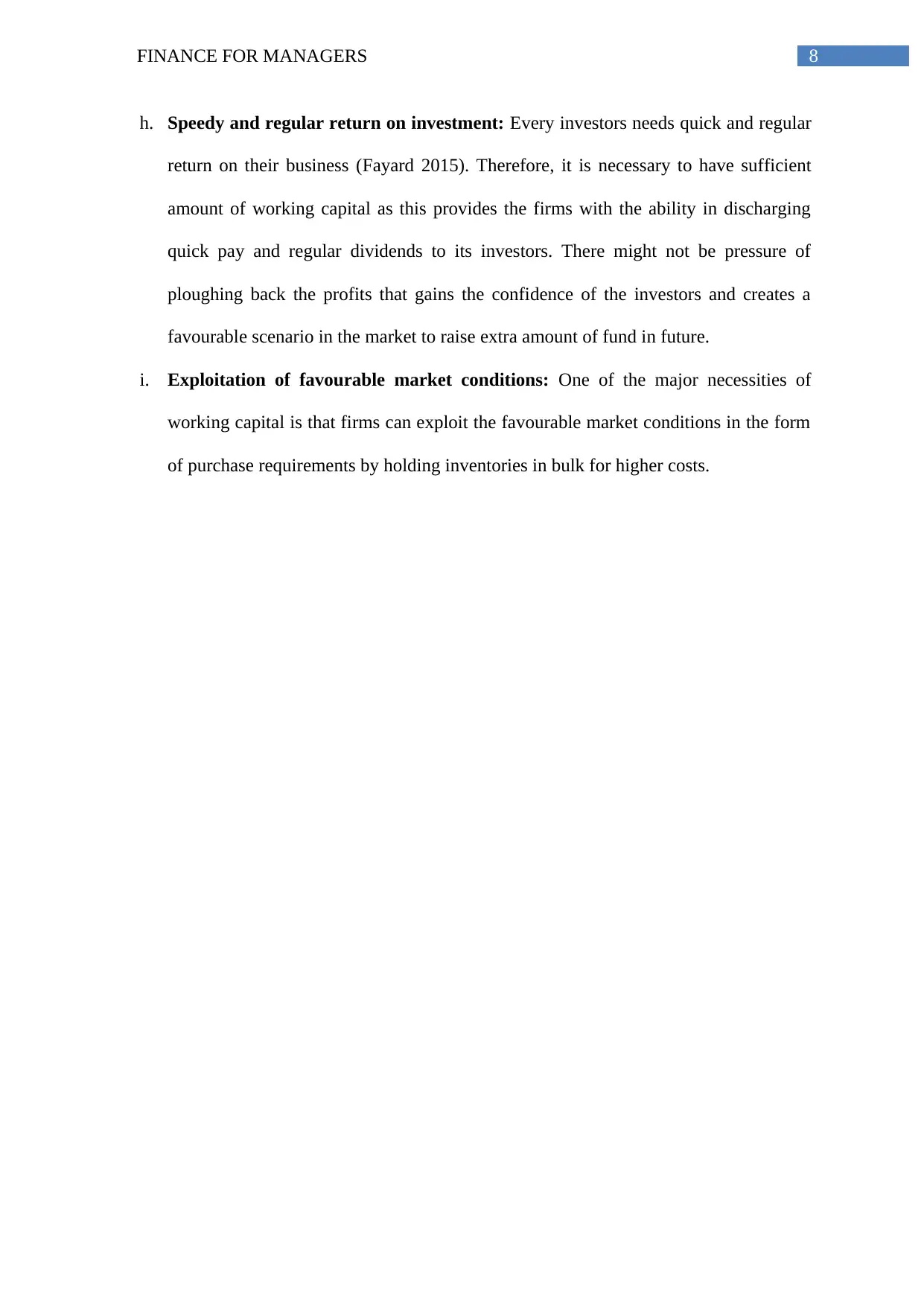
8FINANCE FOR MANAGERS
h. Speedy and regular return on investment: Every investors needs quick and regular
return on their business (Fayard 2015). Therefore, it is necessary to have sufficient
amount of working capital as this provides the firms with the ability in discharging
quick pay and regular dividends to its investors. There might not be pressure of
ploughing back the profits that gains the confidence of the investors and creates a
favourable scenario in the market to raise extra amount of fund in future.
i. Exploitation of favourable market conditions: One of the major necessities of
working capital is that firms can exploit the favourable market conditions in the form
of purchase requirements by holding inventories in bulk for higher costs.
h. Speedy and regular return on investment: Every investors needs quick and regular
return on their business (Fayard 2015). Therefore, it is necessary to have sufficient
amount of working capital as this provides the firms with the ability in discharging
quick pay and regular dividends to its investors. There might not be pressure of
ploughing back the profits that gains the confidence of the investors and creates a
favourable scenario in the market to raise extra amount of fund in future.
i. Exploitation of favourable market conditions: One of the major necessities of
working capital is that firms can exploit the favourable market conditions in the form
of purchase requirements by holding inventories in bulk for higher costs.
⊘ This is a preview!⊘
Do you want full access?
Subscribe today to unlock all pages.

Trusted by 1+ million students worldwide
1 out of 9
Related Documents
Your All-in-One AI-Powered Toolkit for Academic Success.
+13062052269
info@desklib.com
Available 24*7 on WhatsApp / Email
![[object Object]](/_next/static/media/star-bottom.7253800d.svg)
Unlock your academic potential
Copyright © 2020–2025 A2Z Services. All Rights Reserved. Developed and managed by ZUCOL.





